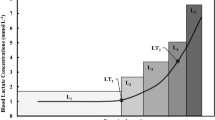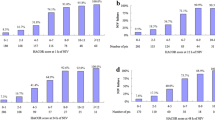Abstract
Purpose
Exercise oscillatory ventilation (EOV) is a form of periodic breathing that is associated with a poor prognosis in heart failure patients, but little is known about EOV in other populations. We sought to provide insights into the phenomenon of EOV after it was observed in young healthy subjects, including athletes, after the administration of dual autonomic blockade (DAB).
Methods
From 29 participants who completed cardiopulmonary exercise testing (CPET) with and without DAB (0.04 mg/kg atropine and 0.2 mg/kg metoprolol), 5 subjects developed EOV (age = 29 ± 5 years; 3/5 were athletes) according to American Heart Association criteria. For each case, we identified 2 non-EOV healthy controls (age = 34.2 ± 8.3; 7/10 were athletes) that were subsequently age- and sex-matched.
Results
No participants had EOV during exercise without DAB. The 5 participants (4 male, 1 female) who demonstrated EOV with DAB had lower mean tidal volume (1.7 ± 0.5 L/min vs. 1.8 ± 0.5 L/min; p = 0.04) compared to participants in the non-EOV group and a decrease in peak tidal volume (2.9 ± 0.6 L/min to 2.2 ± 0.7 L/min; p = 0.004) with DAB. There were few other differences in CPET measures between EOV and non-EOV participants, although the PETCO2 tended to be higher in the EOV group (p = 0.07).
Conclusion
EOV can be elucidated in young healthy subjects, including athletes, during cardiopulmonary exercise testing, suggesting that it may not be an ominous sign in all populations.



Similar content being viewed by others
References
Agostoni P, Corra U, Emdin M (2017) Periodic breathing during incremental exercise. Ann Am Thorac Soc 14(Supplement_1):S116–S122
Cahalin LP, Forman DE, Chase P, Guazzi M, Myers J, Bensimhon D, Peberdy MA, Ashley E, West E, Arena R (2013) The prognostic significance of heart rate recovery is not dependent upon maximal effort in patients with heart failure. Int J Cardiol 168(2):1496–1501
Cornelis J, Taeymans J, Hens W, Beckers P, Vrints C, Vissers D (2015) Prognostic respiratory parameters in heart failure patients with and without exercise oscillatory ventilation—a systematic review and descriptive meta-analysis. Int J Cardiol 182:476–486
Corra U (2016) Exercise oscillatory ventilation in heart failure. Int J Cardiol 206(Suppl):S13–S15
Corra U, Giordano A, Bosimini E, Mezzani A, Piepoli M, Coats AJ, Giannuzzi P (2002) Oscillatory ventilation during exercise in patients with chronic heart failure: clinical correlates and prognostic implications. Chest 121(5):1572–1580
Corra U, Pistono M, Mezzani A, Braghiroli A, Giordano A, Lanfranchi P, Bosimini E, Gnemmi M, Giannuzzi P (2006) Sleep and exertional periodic breathing in chronic heart failure: prognostic importance and interdependence. Circulation 113(1):44–50
Dhakal BP, Lewis GD (2016) Exercise oscillatory ventilation: mechanisms and prognostic significance. World J Cardiol 8(3):258–266
Dhakal BP, Murphy RM, Lewis GD (2012) Exercise oscillatory ventilation in heart failure. Trends Cardiovasc Med 22(7):185–191
Francis DP, Davies LC, Willson K, Ponikowski P, Coats AJ, Piepoli M (2000) Very-low-frequency oscillations in heart rate and blood pressure in periodic breathing: role of the cardiovascular limb of the hypoxic chemoreflex. Clin Sci (lond) 99(2):125–132
Guazzi M, Raimondo R, Vicenzi M, Arena R, Proserpio C, Sarzi Braga S, Pedretti R (2007) Exercise oscillatory ventilation may predict sudden cardiac death in heart failure patients. J Am Coll Cardiol 50(4):299–308
Guazzi M, Arena R, Pellegrino M, Bandera F, Generati G, Labate V, Alfonzetti E, Villani S, Gaeta MM, Halle M, Haslbauer R, Phillips SA, Cahalin LP (2016) Prevalence and characterization of exercise oscillatory ventilation in apparently healthy individuals at variable risk for cardiovascular disease: a subanalysis of the EURO-EX trial. Eur J Prev Cardiol 23(3):328–334
La Gerche A, Claessen G, Van de Bruaene A, Pattyn N, Van Cleemput J, Gewillig M, Bogaert J, Dymarkowski S, Claus P, Heidbuchel H (2013) Cardiac MRI: a new gold standard for ventricular volume quantification during high-intensity exercise. Circ Cardiovasc Imaging 6(2):329–338
Murphy RM, Shah RV, Malhotra R, Pappagianopoulos PP, Hough SS, Systrom DM, Semigran MJ, Lewis GD (2011) Exercise oscillatory ventilation in systolic heart failure: an indicator of impaired hemodynamic response to exercise. Circulation 124(13):1442–1451
Neviere R, Edme JL, Montaigne D, Boleslawski E, Pruvot FR, Dharancy S (2014) Prognostic implications of preoperative aerobic capacity and exercise oscillatory ventilation after liver transplantation. Am J Transplant 14(1):88–95
Okumura T, Hirashiki A, Kono Y, Ohshima S, Takeshita K, Cheng X, Yamada S, Murohara T (2010) Prognosis and mechanism of exercise oscillatory ventilation during exercise testing in patients with idiopathic dilated cardiomyopathy. J Cardiac Fail 16(9):S146
Olson LJ, Arruda-Olson AM, Somers VK, Scott CG, Johnson BD (2008) Exercise oscillatory ventilation: instability of breathing control associated with advanced heart failure. Chest 133(2):474–481
Panagopoulou N, Karatzanos E, Dimopoulos S, Tasoulis A, Tachliabouris I, Vakrou S, Sideris A, Gratziou C, Nanas S (2017) Exercise training improves characteristics of exercise oscillatory ventilation in chronic heart failure. Eur J Prev Cardiol 24(8):825–832
Pardaens S, Vanderheyden M, Calders P, Willems AM, Bartunek J, de Sutter J (2014) Activation of the ergoreceptors in cardiac patients with and without heart failure. J Card Fail 20(10):747–754
Ponikowski P, Francis DP, Piepoli MF, Davies LC, Chua TP, Davos CH, Florea V, Banasiak W, Poole-Wilson PA, Coats AJ, Anker SD (2001) Enhanced ventilatory response to exercise in patients with chronic heart failure and preserved exercise tolerance: marker of abnormal cardiorespiratory reflex control and predictor of poor prognosis. Circulation 103(7):967–972
Randerath W, Verbraecken J, Andreas S, Arzt M, Bloch KE, Brack T, Buyse B, De Backer W, Eckert DJ, Grote L, Hagmeyer L, Hedner J, Jennum P, La Rovere MT, Miltz C, McNicholas WT, Montserrat J, Naughton M, Pepin JL, Pevernagie D, Sanner B, Testelmans D, Tonia T, Vrijsen B, Wijkstra P, Levy P (2017) Definition, discrimination, diagnosis and treatment of central breathing disturbances during sleep. Eur Respir J 49(1):1–28
Toyry JP, Niskanen LK, Mantysaari MJ, Lansimies EA, Uusitupa MI (1996) Occurrence, predictors, and clinical significance of autonomic neuropathy in NIDDM. Ten-year follow-up from the diagnosis. Diabetes 45(3):308–315
Van De Borne P, Hausberg M, Hoffman RP, Mark AL, Anderson EA (1999) Hyperinsulinemia produces cardiac vagal withdrawal and nonuniform sympathetic activation in normal subjects. Am J Physiol 276(1):R178–R183
Vangesselen S, Weymans M, Mertens L, Gewillig M, Reybrouck T (2005) A Java software for calculating mean breath-by-breath variability in gas exchange parameters: application in young cardiac patients with exercise-related periodic breathing. Comput Methods Programs Biomed 80(1):89–92
Zurek M, Corra U, Piepoli MF, Binder RK, Saner H, Schmid JP (2012) Exercise training reverses exertional oscillatory ventilation in heart failure patients. Eur Respir J 40(5):1238–1244
Funding
This study funded by a project grant from the National Health and Medical Research Council (NHMRC) of Australia (APP1130353: Atrial remodelling and risk of arrhythmias in endurance athletes). ALG is supported by a Future Leader Fellowship from the National Heart Foundation of Australia (102021—Utility of novel exercise imaging to identify sub-clinical cardiovascular disease).
Author information
Authors and Affiliations
Contributions
ALG contributed to the conception and design of the research. ALG and FS contributed to the acquisition of data. Analysis and interpretation of the data was done by AJ, FS, MN, KN, ME, and ALG. Drafting of the manuscript was done by AJ and critically revised by FS, MN, KN, ME, VM and ALG.
Corresponding author
Ethics declarations
Conflict of interest
The authors declare that no conflict of interest exists.
Additional information
Communicated by Susan Hopkins.
Publisher's Note
Springer Nature remains neutral with regard to jurisdictional claims in published maps and institutional affiliations.
Rights and permissions
About this article
Cite this article
Jeklin, A.T., Sully, F., Flannery, D. et al. Exercise oscillatory ventilation during autonomic blockade in young athletes and healthy controls. Eur J Appl Physiol 121, 2499–2507 (2021). https://doi.org/10.1007/s00421-021-04720-6
Received:
Accepted:
Published:
Issue Date:
DOI: https://doi.org/10.1007/s00421-021-04720-6




